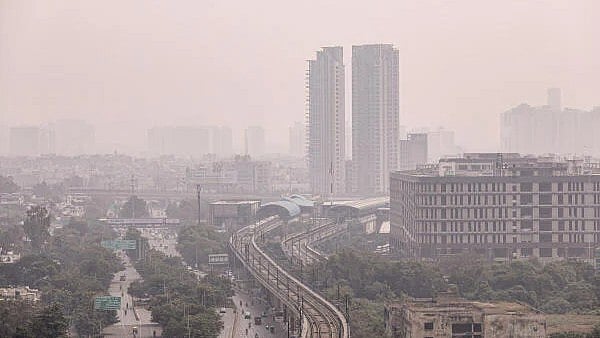
A thick layer of smog blankets Delhi after the air quality deteriorated across the national capital.
Credit: PTI Photo
Delhi continues to witness toxic air conditions with several regions of the national capital recording an air quality index (AQI) of over 400, which is categorised as "severe".
What is GRAP?
Graded Response Action Plan (GRAP) is a set of actions to tackle severely high levels of air pollution. It is an emergency response procedure brought into action depending on different air quality index (AQI) levels.
Stages in GRAP
- Stage 1 for poor air quality (AQI 201-300)
- Stage 2 for very poor air quality (AQI301-400)
- Stage 3 for severe air quality (AQI 301-500)
- Stage 4 for Severe+ air quality (AQI>450/500)
When a higher stage of GRAP is activated, the actions from the earlier stages remain in place. So, GRAP is a step-by step escalation of actions as and when pollution aggravates, with an aim to reduce increas ein air pollution levels.
AQI in Delhi
At 7 am, Jahangirpuri recorded an AQI of 455, placing it in the severe category. Other areas above an AQI of over 400 included Rohini (458), Delhi Technological University (444), Anand Vihar (442), Bawana (439), Ashok Vihar (436), Burari (433), Alipur (412), ITO (409), and Dwarka (401), all showing high levels of pollution.
Further, in the National Capital Region (NCR), Noida was close to the severe category, with an AQI of 396. Greater Noida registered an AQI of 399, categorized as "very poor", though nearly severe.
Meanwhile, Gurugram showed better conditions, with an AQI of 291 in the "poor" category.
The Supreme Court order
Some of the measures of Stage 4 of GRAP will be taken in Stage 3, the Commission for Air Quality Management (CAQM) has said.
The CAQM cited the Supreme Court's order of November 19 where it permitted CAQM and the Central Pollution Control Board (CPCB) to impose stricter restrictions under GRAP regime keeping in mind the emerging situations.
It also asked the commission to proactive actions based on consultation with stakeholders for preventing further deterioration of air quality in Delhi-NCR.
GRAP Stage 4 measures to be implemented in Stage 3
50% strength
The order states that the NCR governments can take a decision on allowing public, municipal and private offices to work on 50 per cent strength and the rest to work from home.
Work from Home
Similarly, the Centre can decide on work from home for central govrnment employees in central government offices.
The order stated, "All agencies responsible for implementation of GRAP are now required to take note of the modifications made in the Schedule of GRAP and implement the same immediately."
Strict enforcement of Stage 3 in Delhi
CAQM stressed that Stage 3, and not Stage 4, of the GRAP remains in force across the NCR.
Chairing a high-level review meeting, Delhi Chief Minister Rekha Gupta directed for a strict enforcement of Stage 3, increased the number of enforcement teams to 2,088 and ordered immediate action against the construction sites violating pollution norms.
Changes coming into effect after GRAP 3 imposition in Delhi
Below are the changes that went into effect after GRAP 3 imposition in Delhi:
- Ban on construction and demolition activities in NCR.
- Demolition, earthwork, trenching, transport of construction material will be prohibited.
- In Delhi and NCR districts including Gurugram, Faridabad, Gautam Budh Nagar, plying of BS-III petrol and BS-IV diesel four-wheelers will be prohibited.
- Inter-state buses that are non-electric, non-CNG, and non-BS-VI diesel will be restricted from entering Delhi.
- Inter-state buses that are non-electric, non-CNG, and non-BS-VI diesel will be restricted from entering Delhi.
- On-Delhi-registered light commercial vehicles (LCVs) are also banned.
(With PTI inputs)
